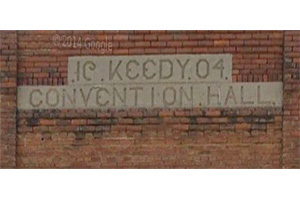
 |
 |
||||||||||||||||||||||||||||||||||||||||||||||||||||
Decline in the 20s? You don't think anything declined in the 20s. It's still the second-largest city in Maine, with a population of 36K. Well, let's see what's still around. Chances are, U do:
It looks as if they added those windows at the back later. Or not; could have been done at the time. No sense knocking on any doors to ask. Vacant lot next door, but of course once it had a building whose exact dimensions you can determine by its absence.
This is nice:
Part of the Lower Lisbon Street Historical District, which no doubt awaits the renaissance promised by such declarations.
Still a furniture building; same name. Look at the size of that boarded up window on the left:
Is there any better way - short of demolition - to tell people that things are shutting down, and shutting down for good?
So you're telling me the demographics have changed since the war:
Hello, my good man, I would like to do some Mogadishu business
SUPPORTERS ELASTIC HOSE DRINK COCA COLA Around the corner:
The town's Wikipedia page said "The city's flagship department store, the four-story B. Peck & Co., closed in 1982 after more than a century in business." I wonder if that's it. More fine restoration work:
They left their mark everywhere, and made sure it didn't fade.
Good golly Miss Molly:
City Hall. That's a sign of a prosperous town. The tower is completely unnecessary - except as an expression of civic pride and power, in which case it's completely necessary.
I have the feeling the depositors didn't win out in the end.
Depositors Trust Company? I should certainly hope so.
A beautiful original entrance: curved glass and inlaid name.
It was originally a bank, believe it or not. The Lewiston Trust and Safe Deposit Company built it in 1898. It has its own Wikipedia page:
Wouldn't you love a tour?
So the holodeck is malfunctioning today, I guess:
You know just how it tasted - thin crust, little crispy pepperoni cups with a pond of grease in each one. Delicious.
Yelpers like it, and we know what a hard bunch they are to please.
This . . . isn't a good sign.
I think it could be occupied, though - those bricked-up windows have smaller windows, indicating a retrofit. The walkway obviously isn't the prefered means of entrance these days, though. This is even sadder:
There's more. Have a look around.
|
|||||||||||||||||||||||||||||||||||||||||||||||||||||
 |
 Says its
Says its 
































